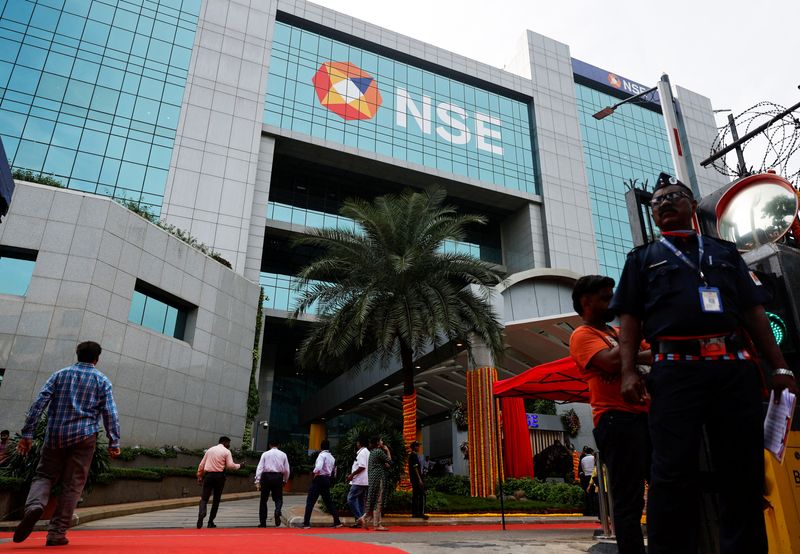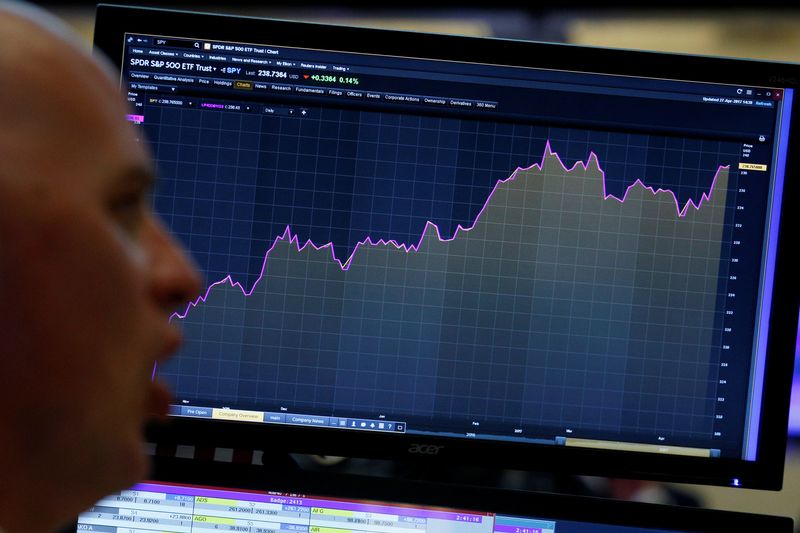Select Language

By Bharath Rajeswaran
BENGALURU (Reuters) -India's NSE Nifty 50 and S&P BSE Sensex are trailing only Wall Street's Nasdaq and S&P 500 as top-performing indexes this year, with analysts expecting the rally to extend into 2025.
The Nifty and Sensex have gained 18.7% and 17% respectively in 2024, securing the third and fourth spots among major global bourses.
The Nasdaq and S&P
have added approximately 22% and 20.5%, slightly ahead of the Indian benchmarks. Japan's Nikkei 225 and Germany's DAX follow India, rising 13% and 12%, respectively.
Earlier this week, India's weightage in a key MSCI index topped China for the first time.
"We expect the Fed rate cut to accelerate foreign inflows and create enough momentum in domestic markets to protect against downsides," analysts at Emkay Global said in a note.
India's stock market rally, driven by expectations of policy continuity following national elections in June and a robust growth outlook, gained further momentum after the U.S. Federal Reserve's significant rate cut on Sept. 18.
Foreign portfolio inflows, which had moderated in August, are on course for to hit a six-month high in September.
The rally has pushed the 12-month forward price-to-earnings ratios of the Sensex and Nifty to 23.6 and 24.4, respectively—the highest among emerging markets. Technical indicators show both indexes are now in overbought territory.
Expectations of soft landing for the U.S. economy will also likely boost sectors like information technology and pharma which earn a significant share of their revenue from the U.S., according to analysts.
Realty, autos, public sector enterprises, pharma and energy are among the top performing sectoral indices so far this year.
Domestic institutional and retail investors have also fueled the stock market buying into all dips.
Domestic institutional investors picked up shares worth a net of 3.23 trillion rupees since the start of the year, according to provisional data from National Stock Exchange.
Mutual funds too have remained net buyers since February 2021 with contributions through the systematic investment plan hitting record highs for 14 months in a row.
This has raised some concerns, with analysts at Jefferies saying the combined domestic inflows through mutual funds, direct participation, insurance and pension funds are "unsustainably high" of $7.5 billion per month between January and August.
The brokerage said it maintained a near-term cautious view on markets, small- and mid-caps.

(Reuters) -SpaceX plans to launch about five uncrewed Starship missions to Mars in two years, CEO Elon Musk said on Sunday in a post on social media platform X.
Earlier this month, Musk had said that the first Starships to Mars would launch in two years "when the next Earth-Mars transfer window opens."
The CEO on Sunday said that the first crewed mission timeline will depend upon the success of the uncrewed flights. If the uncrewed missions land safely, crewed missions will be launched in four years. However, in case of challenges, crewed missions will be postponed by another two years, Musk said.
Musk, known for providing changing timelines on Starship's readiness, said earlier this year that the first uncrewed starship to land on Mars would be within five years, with the first people landing on Mars within seven years.
In June, a Starship rocket survived a fiery, hypersonic return from space and achieved a breakthrough landing demonstration in the Indian Ocean, completing a full test mission around the globe on the rocket's fourth try.
Musk is counting on Starship to fulfill his goal of producing a large, multipurpose next-generation spacecraft capable of sending people and cargo to the moon later this decade, and ultimately flying to Mars.
NASA earlier this year delayed Artemis 3 mission and its first crewed moon landing in half a century using SpaceX's Starship, to September 2026. It was previously planned for late 2025, NASA said.
Japanese billionaire Yusaku Maezawa in June canceled a private mission around the moon he had paid for, which was to have used SpaceX's Starship, citing schedule uncertainties in the rocket's development.

BUENOS AIRES (Reuters) - Argentina's monthly inflation rate stood at 3.9% in August and is expected to close the year at an annualized rate of nearly 123%, according to analysts surveyed by the central bank in a poll published on Thursday.
The new forecast marks a reduction of 4.75 percentage points compared to last month's survey.
Prices are seen rising by 3.5% in September, according to the poll, slowing down after a surge that followed deep spending cuts as well as the devaluation of the peso currency enacted by libertarian President Javier Milei in a bid to reduce sky-high inflation.
Analysts also projected a 3.8% year-on-year drop in the South American economy's real gross domestic product (GDP) for 2024, slightly lower than their prior estimate.
"The activity level would begin to recover in the third quarter of the year, with a rise of 0.9%," according to the survey, while participants estimated growth would average 3.5% in 2025.
The survey polled 42 analysts from August 28-30.
(Report by Nicolas Misculin; Editing by Sonali Paul)

LONDON (Reuters) - Britain needs an additional one trillion pounds ($1.3 trillion) in investment in the next decade to grow the economy, a report said on Friday.
New British Prime Minister Keir Starmer said he wanted the economy to achieve annual growth of 2.5% when campaigning in the run-up to July 4's election - a rate that Britain has not regularly reached since before the 2008 financial crisis.
An annual growth rate of 3% would require extra investment of 100 billion pounds a year in the next 10 years, particularly in energy, housing and venture capital, according to the report from UK financial services lobby group Capital Markets Industry Taskforce.
The investment could come out of the six trillion pounds in long-term capital in Britain's pensions and insurance sector, the report's lead author Nigel Wilson, former boss of Legal & General, told Reuters.
"We've underinvested in the UK for such a long time, there's a massive gap between the other G7 countries and ourselves," he said.
"We have the long-term capital in the UK, it needs to be reallocated."
The British economy needs an extra 50 billion pounds annually in energy investment, as it seeks to meet net zero targets, 30 billion pounds in housing and 20-30 billion in venture capital, the report said.
The government should look at incentives to investment, such as reductions in taxes on shares for retail investors, the report added.
UK pensions have a "significantly lower" allocation to domestic and unlisted equities than most developed market pension systems globally, according to a separate report published on Friday by think tank New Financial.
UK pensions could as much as double their allocations and still be in line with the pensions industry in other advanced markets, the report said.
The UK government has called for a review of Britain's pension system, as it seeks to increase UK pensions investment in domestic startups.
($1 = 0.7594 pounds)

(Reuters) - U.S. Vice President and Democratic presidential candidate Kamala Harris' proposed corporate tax hike ahead of the November Presidential elections could lower earnings for companies on the benchmark S&P 500 index by about 5%, analysts at Goldman Sachs said.
Last month, Harris proposed raising the corporate tax rate to 28% from 21% and ensure "big corporations pay their fair share," if she wins the election against Republican rival Donald Trump.
Goldman estimated that at a 28% taxation rate earnings of S&P 500 companies would take a 5% hit.
Adding taxation of foreign income and an increase in the alternative minimum tax rate to 21% from 15% could reduce earnings by as much as 8%, the analysts said.
On the other hand, Trump's proposed relief on the federal statutory domestic corporate tax rate to 15% from the current 21% would "arithmetically" boost S&P 500 earnings by about 4%.
"The current U.S. statutory corporate tax rate on domestic income is 26%, but the total effective tax rate paid by the typical S&P 500 company is 19%," the brokerage added.
Goldman projected with each 1 percentage point change in the U.S. statutory domestic tax rate the shift in S&P 500 earnings per share (EPS) would be slightly less than 1% or about $2 of S&P 500 EPS.
Harris' rise to the top of the Democratic ticket has re-energized a Democratic campaign that had harbored doubts about Joe Biden's chances.
Polls showed that Trump had built a lead over Biden but Harris has since edged ahead of the Republican candidate in some national opinion polls.

By Tom Sims, Matt Tracy, John O'Donnell and Iain Withers
NEW YORK/LONDON (Reuters) - Global property markets, rattled by the steepest rise in interest rates in a generation, will get little relief from the gradual easing of borrowing costs, with scant hope of a return to the free money that fuelled a boom.
The multi-trillion dollar industry, which thrived in the decade after the global financial crisis when the cost of money was cut to zero, has been one of the biggest casualties as central banks pushed up borrowing costs.
Now central banks, from the European Central Bank and Bank of England to Switzerland and Sweden, are cutting rates, making it cheaper to borrow, with the U.S. Federal Reserve to follow.
But industry executives and bankers see no quick fix for an industry built as rock bottom rates sent trillions flowing into property, money the sector is now haemorrhaging as bonds and ordinary savings accounts regain their appeal.
"We're not out of the woods yet," said Andrew Angeli, global head of real estate research at Zurich Insurance, a Swiss investor, arguing the sector was unlikely to see a rapid recovery.
The past two years of rate hikes have claimed scores of victims, including property group Signa, which owned trophy buildings in Germany, leaving behind a trail of half-built homes and empty skyscrapers.
Property insolvencies in Germany have been rising since early 2022, according to consultants Falkensteg, to reach more than 1,100 in the first six months of this year.
Britain’s construction sector has seen the most insolvencies of any industry for two years running, with roughly 4,300 over the 12 months to June 2024.
The pain is acute for offices, hammered by rising borrowing costs and home working, but the impact is spilling over into the vast housing market, which has sunk in Germany and stuttered in Britain.
"I've never worked so hard in my life and feel like I have nothing to show for it," said Brian Walker, president of the Pittsburgh-based property company NAI Burns Scalo.
"Some will say ... we're probably at the bottom of where the office market is, but I don't know how you can say that," said Walker. "You're starting to see a lot of office buildings keys just go back to the bank."
Cornelius Riese, the CEO of DZ Bank, one of Germany's biggest property lenders, said higher rates would take three years to work their way through the system. "We're almost two thirds of the way into the phase in which surprises can crop up," he said.
An economic slowdown in many countries, including Germany and China, is adding to the jitters.
HIGH STAKES
Real estate investment firm JLL estimates that a total $2.1 trillion worth of commercial real estate debt globally will need to be repaid this and next year. Borrowers secured refinancing deals to cover almost one third of that in the first six months of this year, but there could be a shortfall next year of up to $570 billion, JLL said.
Many U.S. investors have handed back the keys to office blocks to lenders, as Brookfield Asset Management (TSX:BAM) did with New York's Brill Building, a landmark made famous by singers such as Neil Diamond, who began their careers as songwriters there. Brookfield did not immediately return a request for comment.
Some small banks, who went all in as property boomed, are now under threat.
Rebel Cole, a professor of finance at Florida Atlantic University, has identified 62 smaller U.S. banks with outsized property loans.
Cole identified a small number of lenders at risk of going bust as they have investments in the largely paralysed property sector, while relying on funding from big deposits that could be pulled at a moment's notice.
"There's a vast amount of maturities ... on loans going to come down the pike next year," said David Aviram, co-founder of Maverick Real Estate Partners, a New York-based investor.
That is pressuring banks to offload loans by trying to sell them but several, who were offered as little as 40% of the debt's face value, shelved such deals, parking the soured credit on their books instead, said Aviram.
Selling buildings is not easier.
Earlier this year, a company liquidator knocked around 160 million pounds ($209.89 million), or 60%, off the previous purchase price of an office tower in London's Canary Wharf, a source familiar with the matter said, but the sale foundered regardless.
Some believe banks are in denial. European regulators suspect they may be masking the poor state of loans to the sector by ignoring price falls.

By Neil Jerome Morales and Mikhail Flores
MANILA (Reuters) -Philippine annual inflation slowed to a seven-month low in August as price increases on food and transport costs moderated, the statistics agency said on Thursday, giving the central bank room to further ease rates.
The consumer price index (CPI) rose 3.3% in August from a year earlier, below the previous month's 4.4% rise, bringing average inflation to 3.6% in the first eight months of the year, well within the central bank's 2% to 4% comfort range.
Last month's inflation was the slowest since the 2.8% print in January.
Economists in a Reuters poll expected inflation of 3.6%.
The core inflation rate, which strips out volatile food and energy prices, also slowed, to 2.6% last month.
Rice inflation, which accounts for nearly a tenth of overall inflation, eased to 14.7%, the slowest since October 2023. Rice prices could further ease in the coming months, national statistician Dennis Mapa told a briefing.
"It will further go down to single digits because of base-effects," Mapa said.
Philippine President Ferdinand Marcos Jr lowered tariffs on rice to 15% from 35%, but the expected easing in prices was slower than expected.
The Philippine central bank said on Thursday lower rice tariffs would help ease inflation in the coming months. Risks to inflation continued to tilt on the downside this year and the next, with a "slight tilt to the upside" for 2026.
"Going forward, the Monetary Board will continue to take a measured approach in ensuring price stability," the Bangko Sentral ng Pilipinas (BSP) said in a statement.
The August print could further allow the central bank to further ease rates, according to Nicholas Mapa, economist at Metropolitan Bank and Trust Co.
The door to further cuts this year "remains wide open," Mapa said on social media.
The BSP cut its benchmark borrowing rate by 25 basis points to 6.25% in August, its first rate cut since November 2020.
BSP Governor Eli Remolona flagged there is room for one more interest rate cut this year.

(This Sept 3 story has been refiled to clarify that the tariff cuts cover shipments to U.S. Gulf Coast destinations, in paragraph 4 )
By Arathy Somasekhar
HOUSTON (Reuters) - Pipelines that historically carry Canadian crude to the U.S. are cutting rates and looking to ship different grades of crude oil due to rising competition from the newly expanded Trans Mountain pipeline.
The moves will temporarily cut the cost of transporting some of Canada's heavy crude to the U.S. Midwest and Gulf Coast next month. U.S. imports of Canadian crude hit a record in July as Trans Mountain expansion (TMX) volumes grew.
Shipments on TMX started in May, sending up to 890,000 barrels per day (bpd) to Canada's Pacific Coast. About 80% of the volumes are contracted, leaving 20% available for spot shipments.
With more oil moving on TMX, Canadian pipeline operator Enbridge (NYSE:ENB) said in August it will cut its tariffs for September by 11% per barrel on heavy crude moving on its Mainline system to points on the U.S. Gulf Coast. The 3 million-bpd system ships the bulk of Canada's crude exports from Edmonton to the U.S. and is one of the main competitors to TMX.
The company is not rationing pipeline space for September for the first time in over a year, with sufficient capacity available to cover all nominated barrels.
Enbridge said it anticipates Mainline will be well utilized for the remainder of the year, attributing the decrease in volumes to routine oil producer and refiner maintenance.

SEOUL (Reuters) - South Korea's economy shrank 0.2% in the second quarter, revised central bank data showed on Thursday, unchanged from its advance estimate issued in July.
It was the sharpest quarterly contraction since the fourth quarter of 2022 when the economy shrank by 0.5%.
On an annual basis, gross domestic product was 2.3% higher in the April-June quarter, weaker than the 3.3% growth logged in the first quarter.

By Tommy Reggiori Wilkes
LONDON (Reuters) - Britain and the European Union must turn their "first steps" to rebuild trust into a "steady walk" as they confront common challenges, the president of the Eurogroup of euro zone finance ministers said on Tuesday.
Addressing representatives of Britain's financial industry, Paschal Donohoe said his discussions with UK finance minister Rachel Reeves included pensions system reform and unlocking longer-term savings to boost capital markets, as well as the euro zone's drive for an elusive capital markets union.
"Of course, the UK and EU each have to make their own decisions about how to make progress. However, it is really welcome that we have moved onto a new footing in our relationship which allows us to exchange views on these important topics for our citizens and businesses," he said.
"More broadly, I strongly welcome the UK Government's intention to strengthen and deepen relations with the EU," Donohoe, an Irish government minister, told an audience at the medieval Guildhall, home of the City of London Corporation.
Britain's Prime Minister Keir Starmer has sought to reset relations with the EU since coming to power this summer, with improved ties at the heart of his efforts to boost Britain's economic growth.
Donohoe said he welcomed the UK-EU Memorandum of Understanding on Financial Services, signed last year, which enabled meetings of the Joint EU-UK Financial Regulatory Forum.
In a speech titled 'Financing Our Future', the Eurogroup president said progress on a euro zone capital markets union was vital.
"At a time of growing dissatisfaction about the role of market-based solutions and at a time of such widespread budget challenges, making further progress on Capital Markets Union is essential," he said.
Recent work between member states signalled "a sea change in attitudes and political determination".
"To play the 'devil's advocate', without a true capital markets union in Europe, I think the green transition as one prime example, is far less likely to happen," he told the audience in London.

